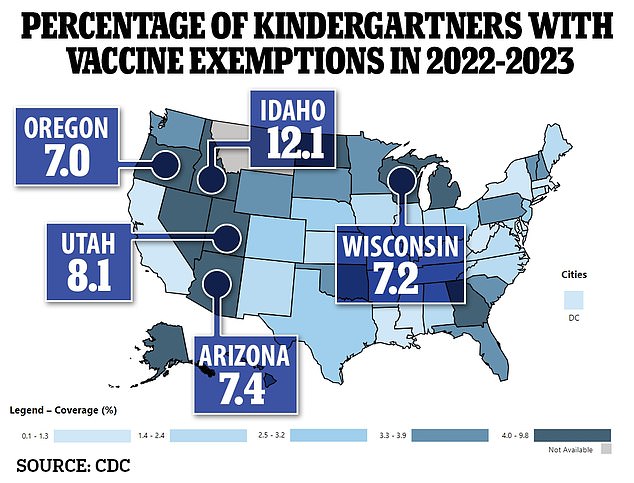CDC warns 270,000 children entered kindergarten unvaccinated last year as anti-vax reached ‘record’ high
More than a quarter of a million preschoolers attend school without the recommended childhood vaccinations – and the number of children exempt from vaccination has reached a peak.
Facts The Centers for Disease Control and Prevention (CDC) shows that national coverage for all vaccines remained nearly 93 percent — down from the 95 percent recorded in the 2019-2020 school year before the pandemic — meaning about 268,000 preschoolers have not been vaccinated.
Moreover, for In the 2022-2023 school year, three percent of kindergarteners had a vaccine exemption from one or more required vaccines — up from 2.6 percent during the 2021-2022 school year and the highest the U.S. has ever recorded.
Vaccinations for children before kindergarten include vaccinations to protect against chickenpox, polio, measles, mumps, rubella, diphtheria, tetanus and whooping cough – no less than cough.
For the 2022-2023 school year, three percent of kindergarten children had a vaccination exemption from one or more mandatory vaccines. This is an increase from 2.6 percent during the 2021-2022 school year and the highest the U.S. has ever recorded

The map above shows vaccine exemption rates by state for the 2022-2023 school year, highlighting the top five states with the highest exemption rates
The states with the highest percentage of preschoolers with vaccine exemptions are unchanged from last year and remain Idaho (12.5 percent), Utah (8.1 percent), Arizona (7.4 percent), Wisconsin (7.2 percent). ) and Oregon (seven percent).
Each state has different guidelines for vaccine requirements and exemptions. While some may require all of the vaccines for kindergarten entry, others may only need a handful of vaccines at that time, deferring others to future grades.
There are two types of vaccine exemptions: medical and non-medical.
The percentage of medical exemptions allowed if a child has a medical condition that prevents them from receiving a vaccine has remained largely consistent over the past twelve school years.
For the 2022-2023 school year, that was 0.2 percent, a figure that remained unchanged from last year.
Non-medical exemptions include exemptions based on religious or philosophical beliefs.
Only a handful of states do not allow these types of exemptions, including New York, California, Connecticut, Maine, Mississippi and West Virginia.
In the most recent school year, the percentage of children claiming this type of exemption increased from 2.3 percent in 2021-2022 to 2.8 percent.
While a small change in percentage may not seem significant, it translates into thousands of children who could be made vulnerable to deadly diseases, threatening herd immunity. can lead to outbreaks of previously eradicated diseases.
Vaccination exemptions may apply to one, more, or all required childhood vaccines. Although rules vary by state, in most cases parents must receive documentation from a doctor stating that a child should be exempt from vaccinations.
The waivers are then reviewed and granted by the child’s school.
However, as the anti-vax movement has grown, so has the number of people filing for false exemptions, with some willing to pay doctors to make up medical excuses to avoid having their child need to be vaccinated.
In some states, lawmakers are cracking down on this practice and even proposing legislation to stop false exemptions.
In 2019, California State Senator Richard Pan advocated for it a bill that would require the state health department to review all medical exemptions and approve or deny them. The bill also created a database to track doctors who granted an unusually high number of waivers.
It passed in September 2019.
Experts have partly attributed the decline in vaccination rates in the US to Covid-19.
While the Covid vaccine is not required for children attending school in the US, it is believed to be a contributing factor to the rise of vaccine hesitancy.
In the school year that followed the introduction of the Covid vaccines, more parents claimed vaccination exemptions: 2.6 percent in 2021-2022, compared to 2.2 percent in 2020-2021.
America’s top infectious disease expert, Dr. Anthony Fauci, admitted that Covid vaccine policies were “counterproductive” and that vaccine skeptics were turning away from vaccinations rather than winning their favor.
Earlier this year he said told The New York Times: “Man, I think almost paradoxically there were people who were hesitant to get vaccinated and thought, Why are they making me do this?
‘And that sometimes beautiful, independent streak in our country is becoming counterproductive. And you have this smoldering anti-science feeling, a division that is palpable politically in this country.”
